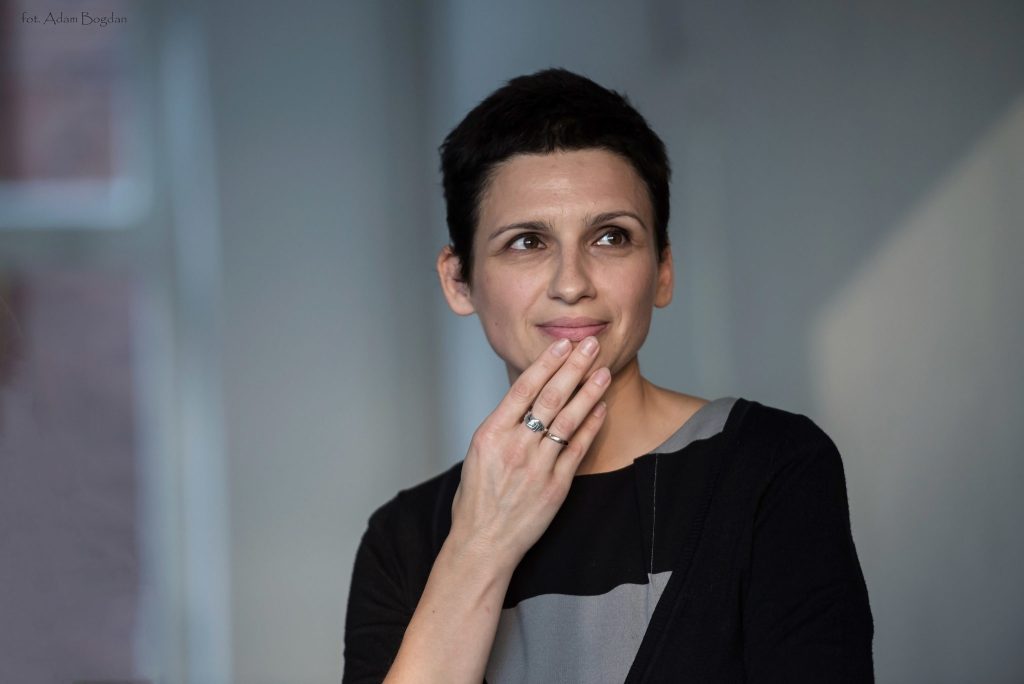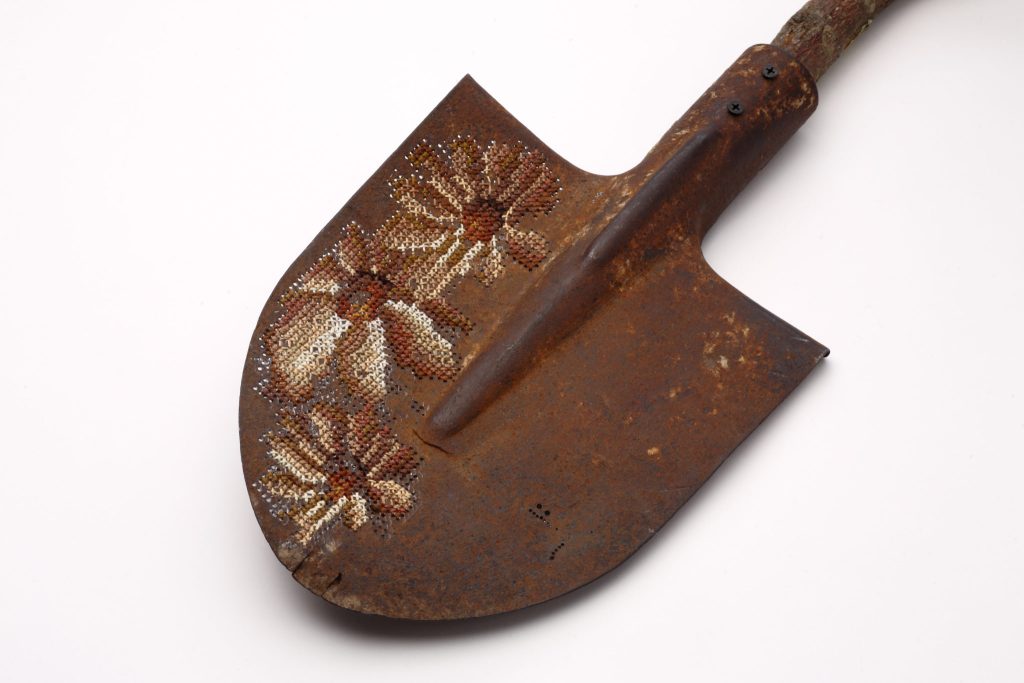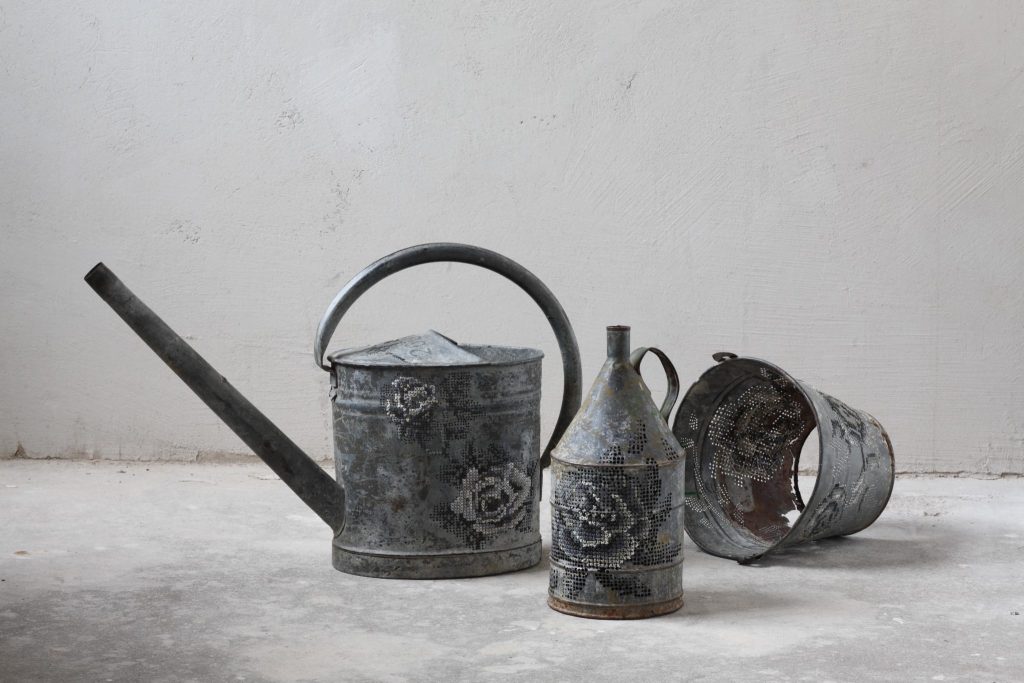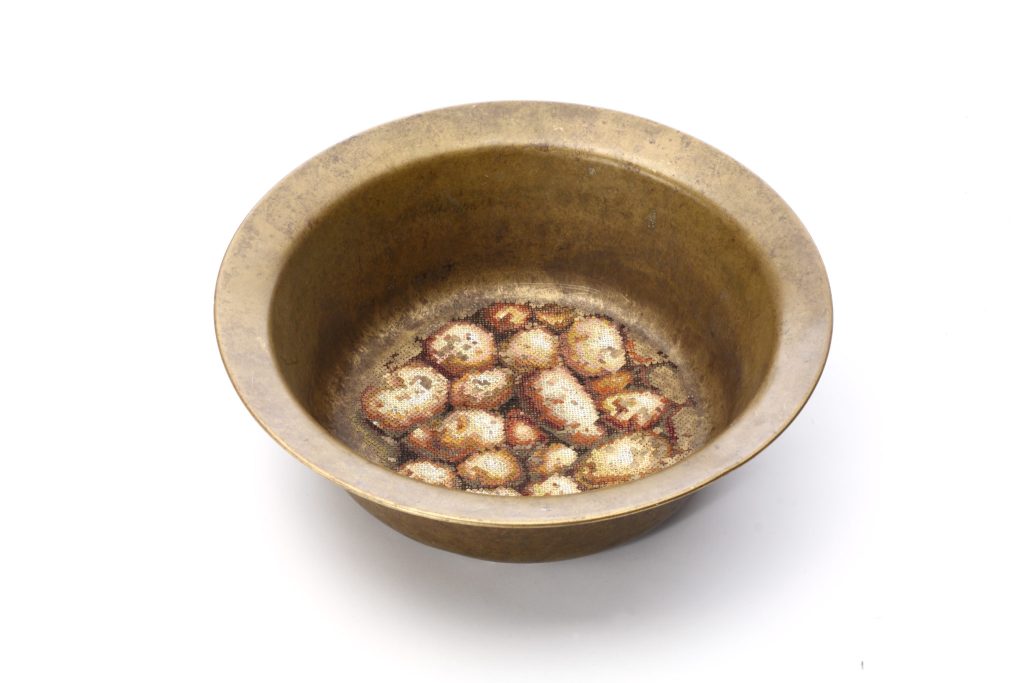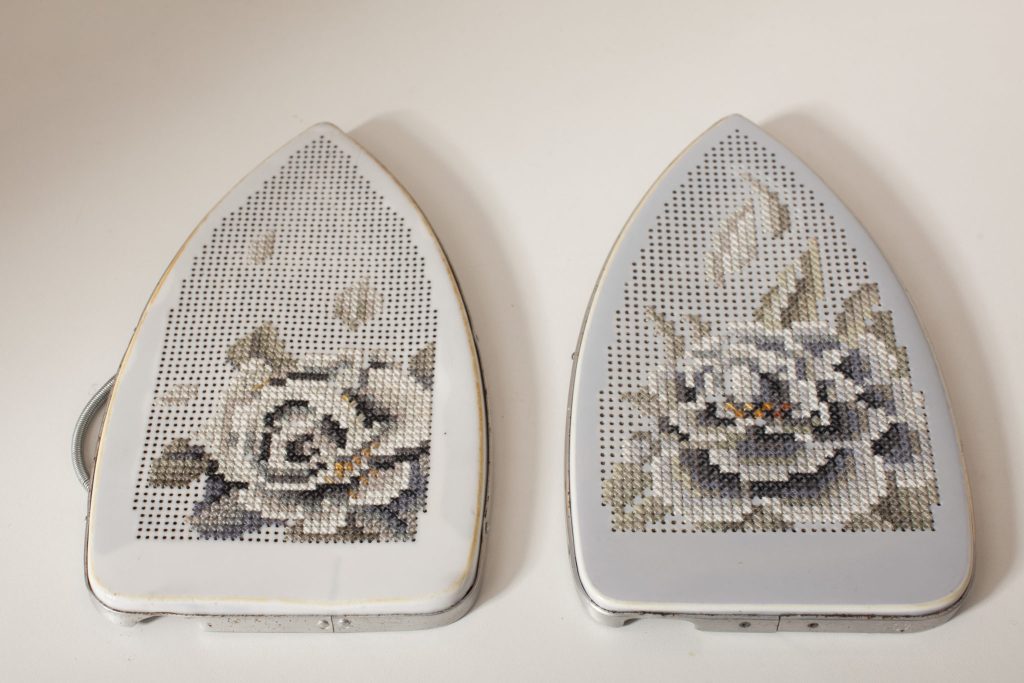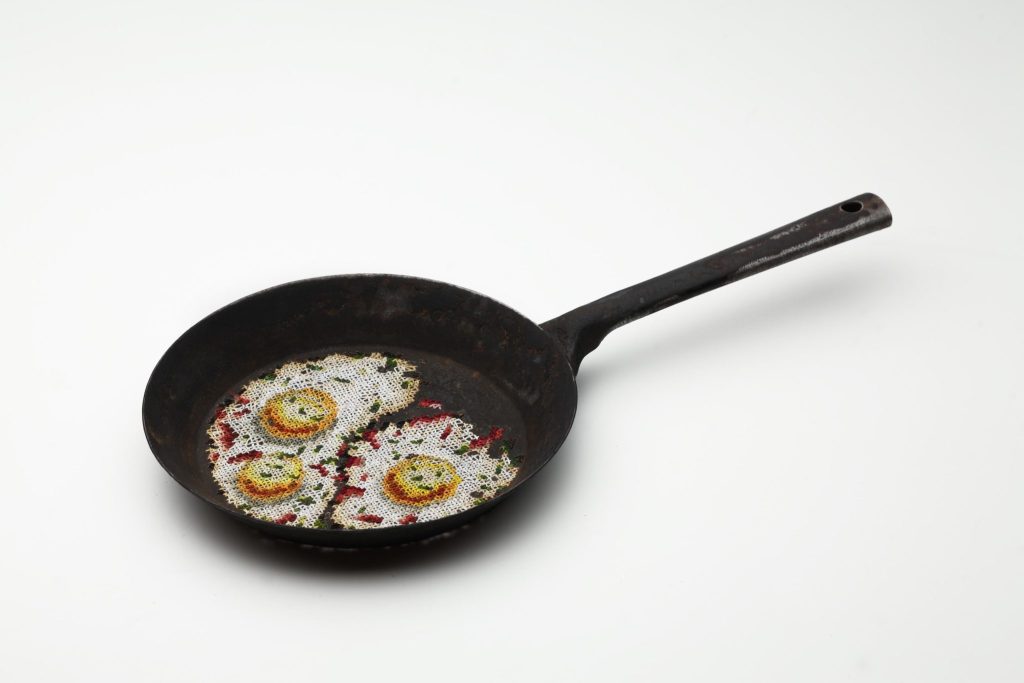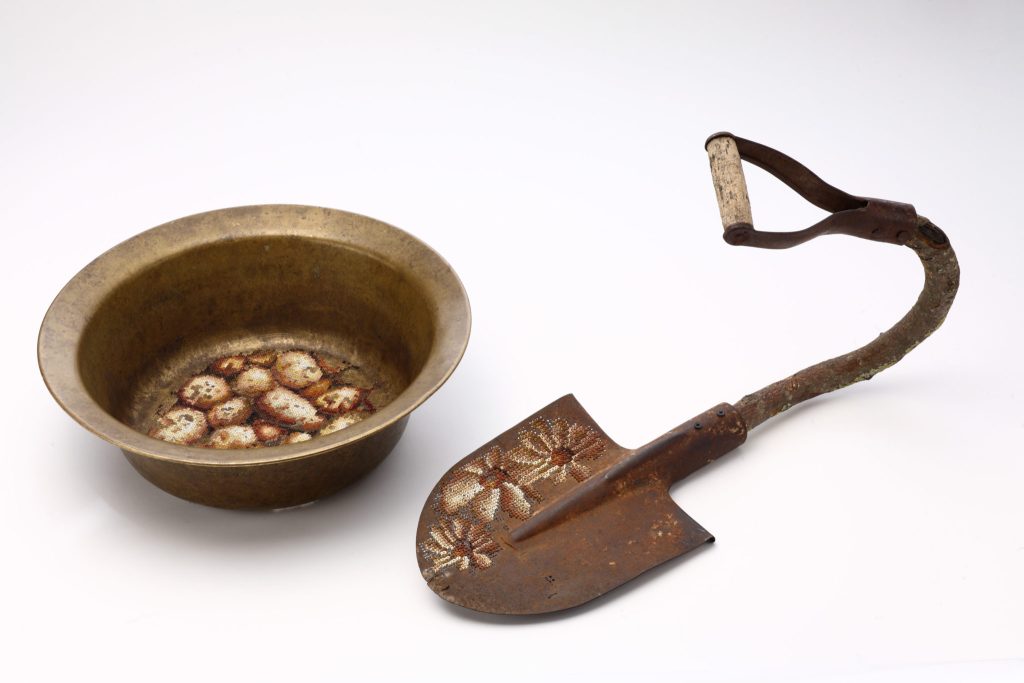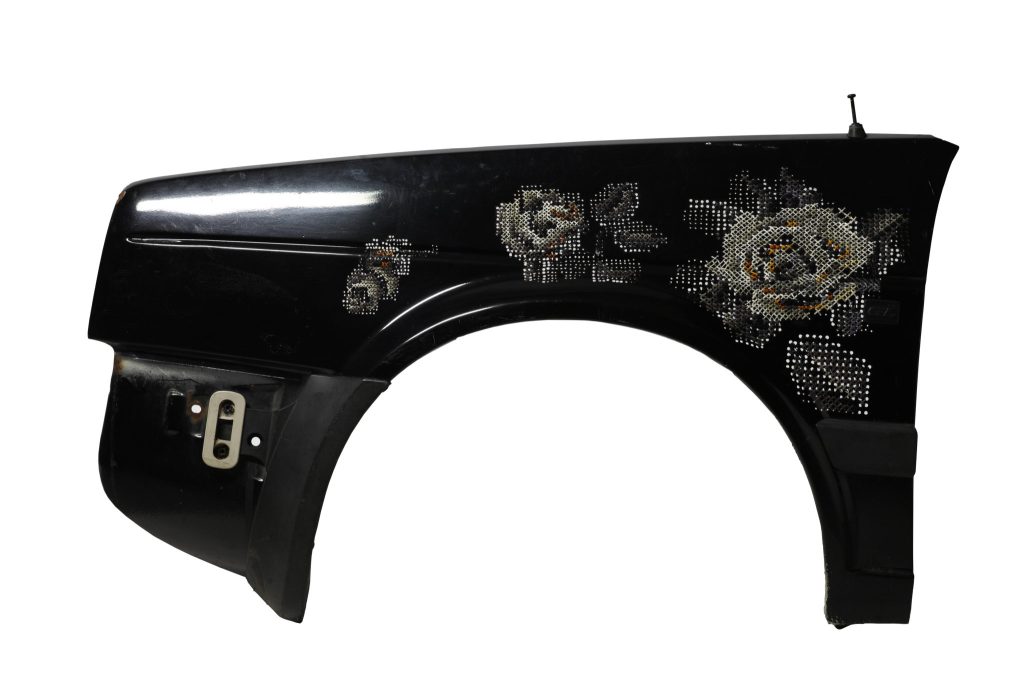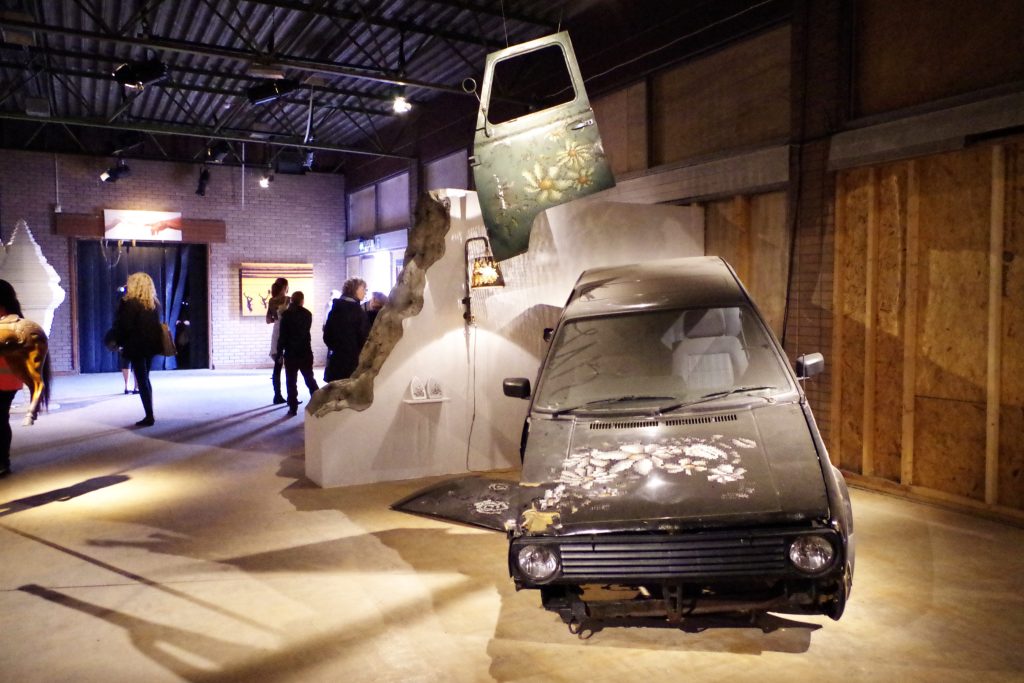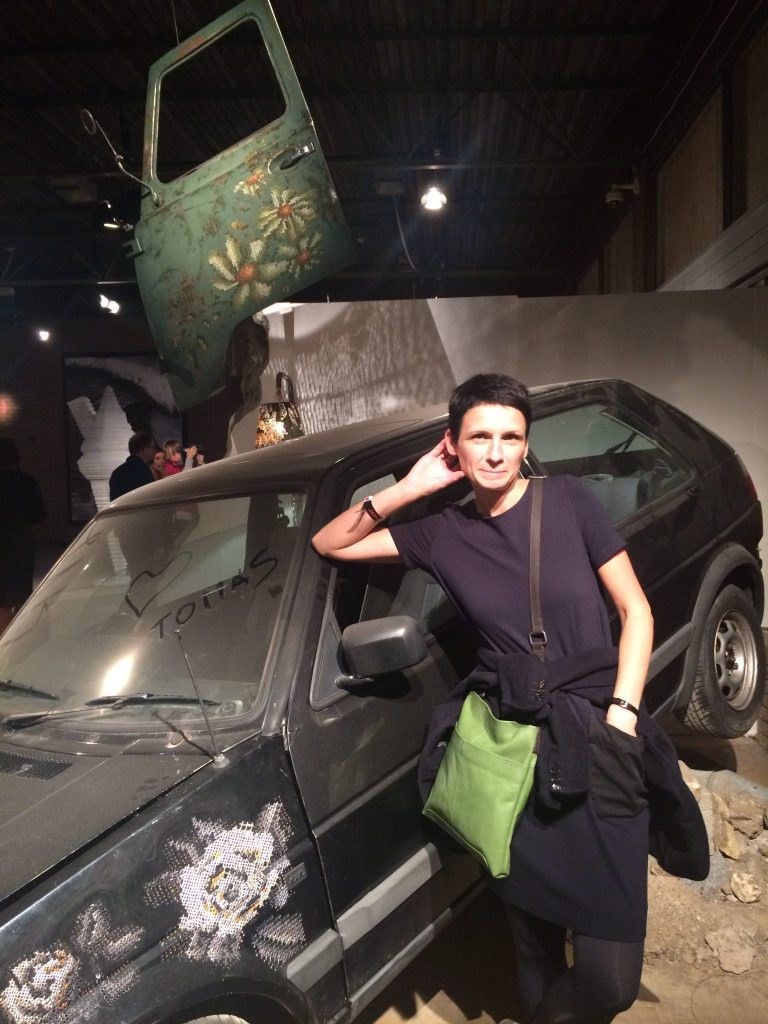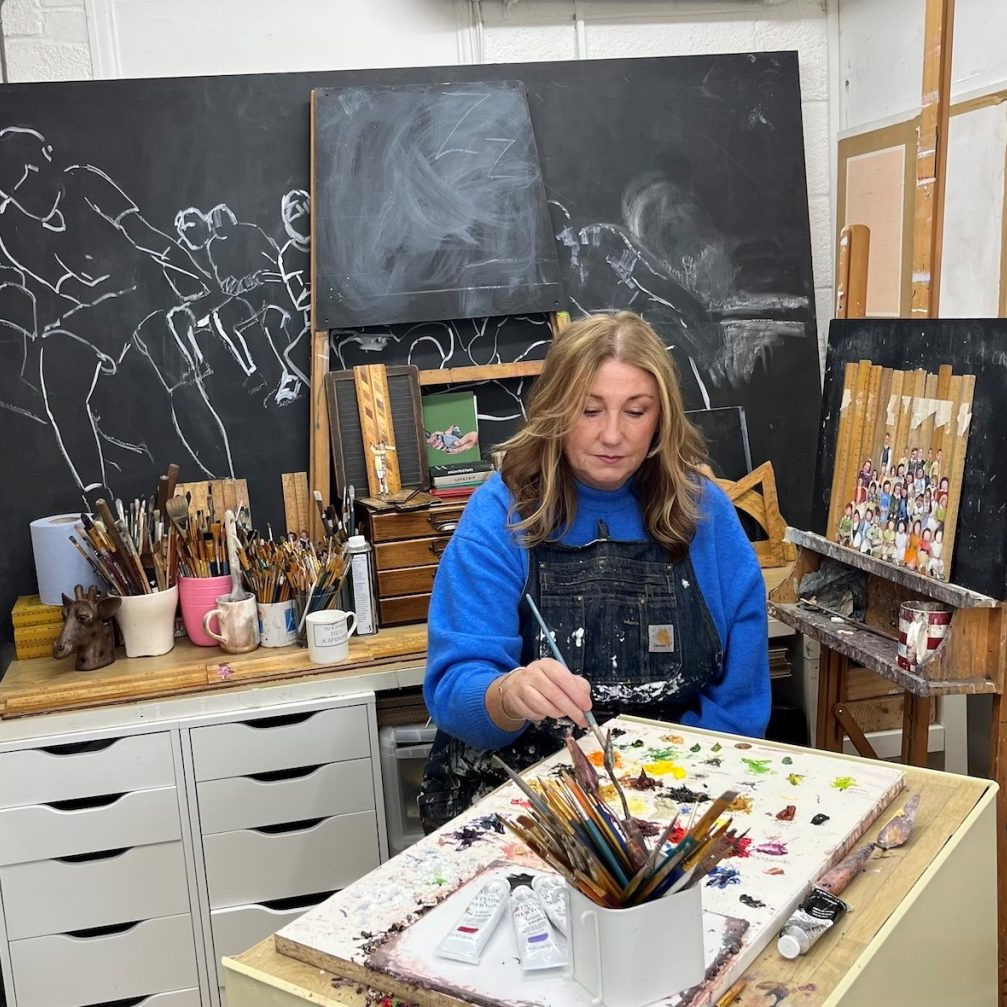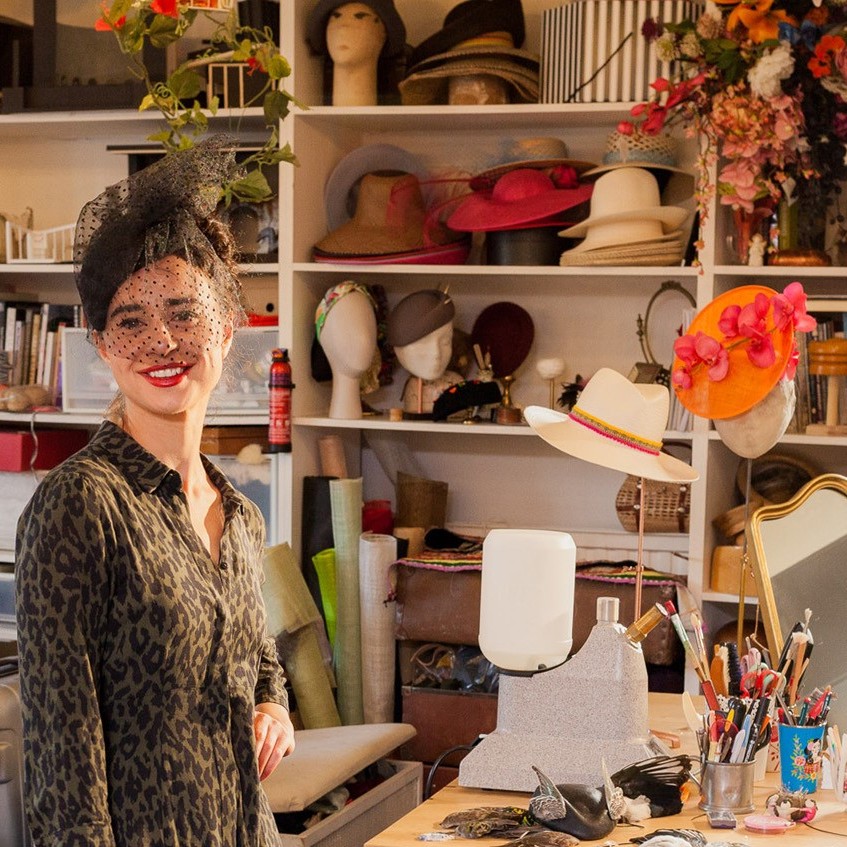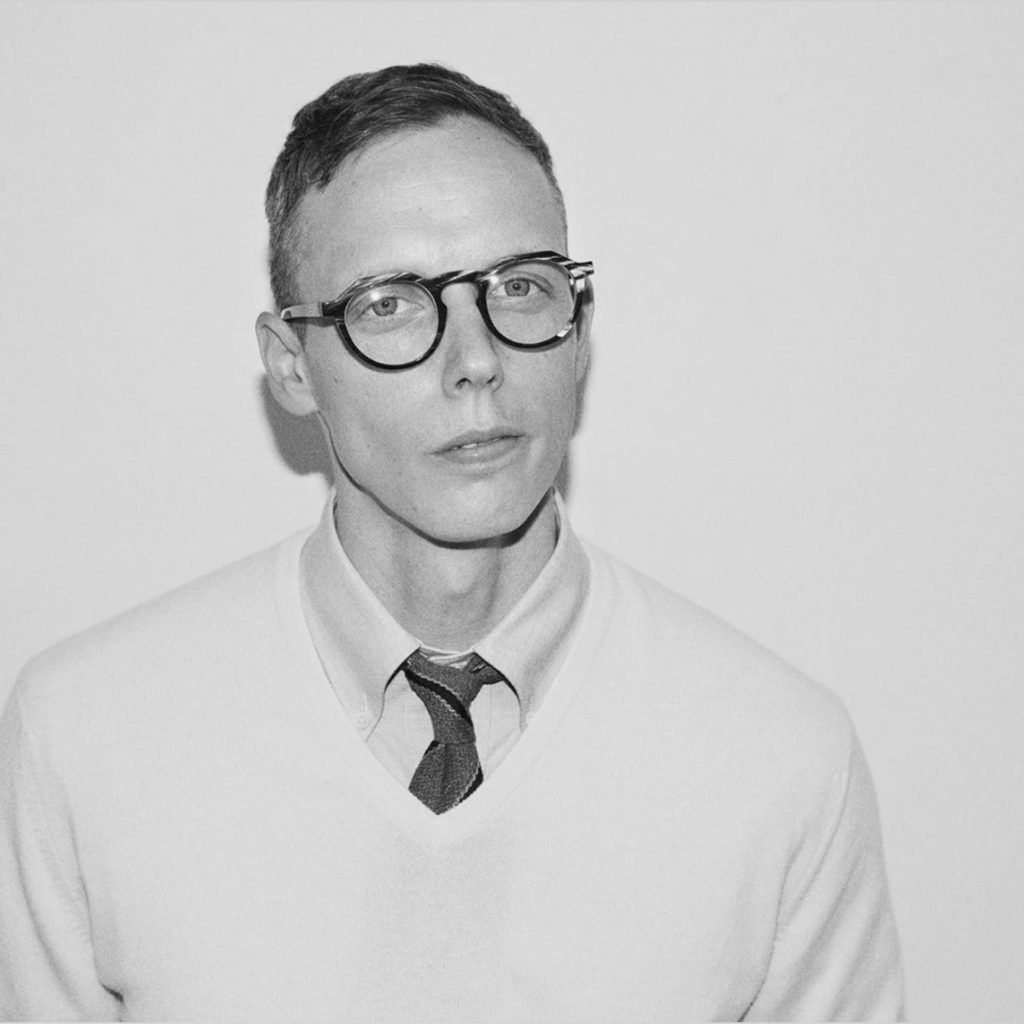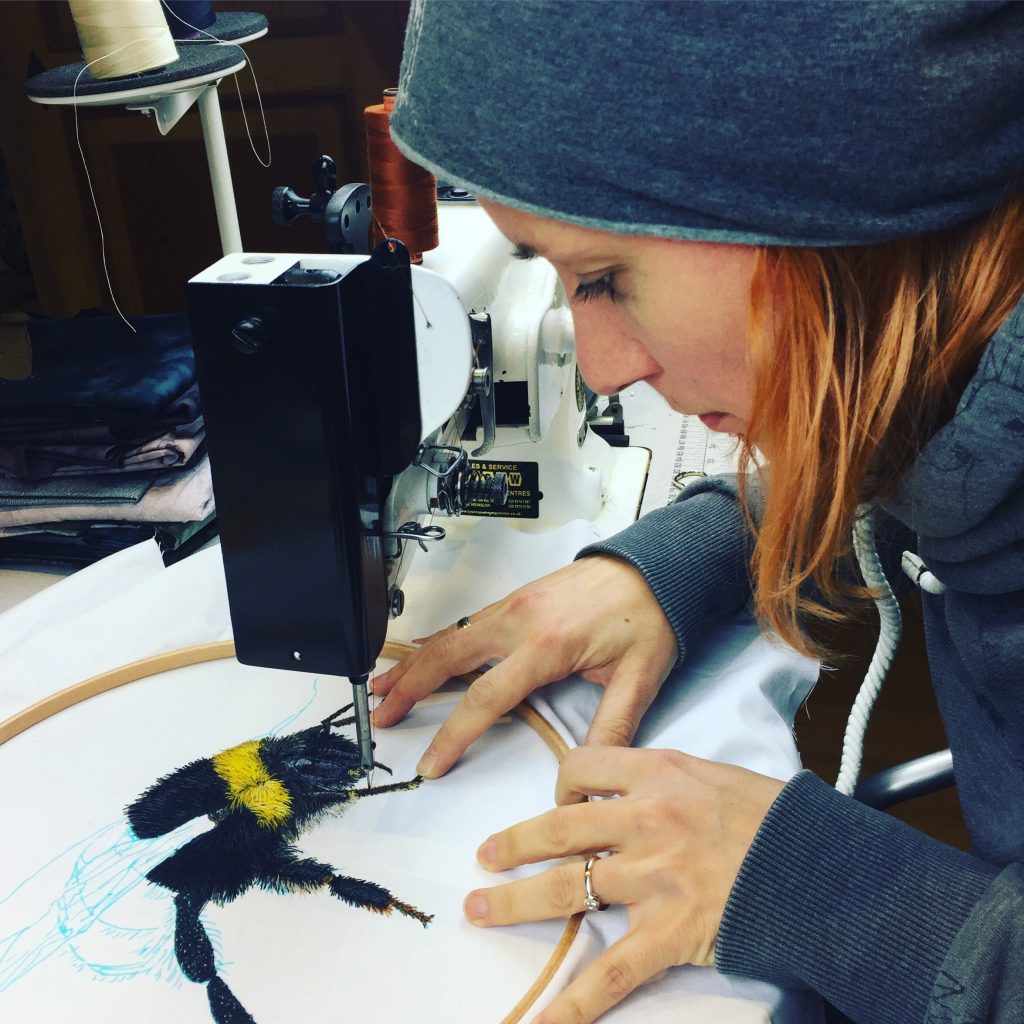Severija Inčirauskaitė-Kriaunevičienė Textile Artist - Vilnius, Lithuania
Can you explain how you first began this combination of metal and embroidery?
I will admit that this is one of the most popular questions I get asked. Therefore, it is not surprising that you are asking me the same thing. So…
Art critics and journalist like to associate this particular technique with my parents. Both of them are artists and professors at the Vilnius Academy of Arts (Telšiai Faculty). My father mainly uses metal in his creative practice, he makes sculptures, medals, reliefs in metal, whereas my mother, being a professional calligrapher, combines this particular art with textiles. Thus, to the majority, it may seem that the art of their daughter is the synthesis between the creative expressions of both parents.
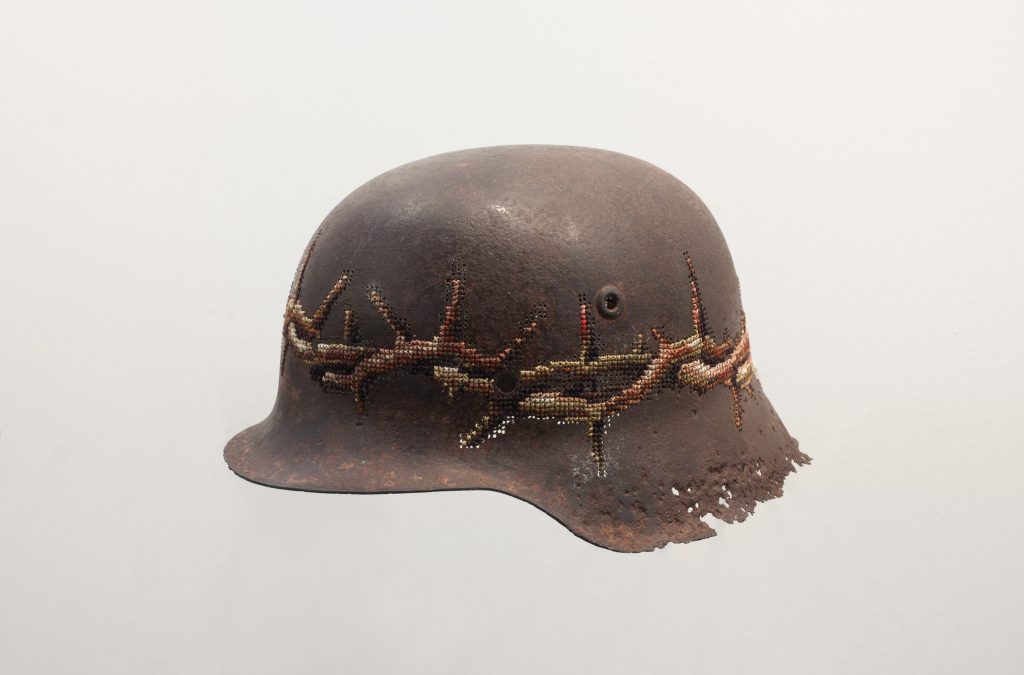
Kill for Peace, Photo by Vidmanatas-Ilčiukas
I cannot agree with this, I cannot deny it either. By the way, I should mention, that metal came into my creative practice only in 2004, before that and in my later works I have worked with different materials as well. Having grown up in an artistic environment where I saw my father creating these incredibly complex metal objects out of what may seem like a rigid and hard to yield material, I never had a fear of working with metal (for many people metal might seem like an insurmountable or resistant material), I always knew that you could make anything out of metal. All you need is knowledge and a wealth of experience (my father studied metal art at Telšiai Applied Arts School and later at Tallinn Art School, therefore he is a professional in this field). And the textile knowledge, like for many women of my and older generation is simply an integral part of daily life (even in first grade, assisted by my mother, I was able to knit myself an incredibly lifelike doll).
Although all of the aforementioned things really had a certain (perhaps unconscious) influence on my work, I have another explanation, which I believe is more important. I discovered metal after my Textile Art studies, and I can say that it was the Textile Art studies that influenced the appearance of non-textile materials in my creative work (for 5 years I studied Costume Design at Telšiai Applied Arts School, where both of my parents studied as well, although, in their time it was known by a different name (now it’s the Vilnius Academy of Arts, Telšiai Faculty), later for 6 years I studied for a BA and MA at the Vilnius Academy of Arts, Textile department, and after that for 2 more years in the postgraduate study at the same institution). I understand and know very well textile materials and all of their possibilities. The main qualities of textile, such as softness, permanent creasing and the instability of form always irritated me and seemed to be out of my control. During my years of study, I realised that for me the important thing was the three-dimensional form (not the flatness) and that in textiles it is difficult to create a three-dimensional shape. Although there is an area of textiles called “soft sculpture”, however, I am more interested in the strong, clear and stable form. Also, whilst studying I realized that in my creative practice the notion of re-making was very important, sometimes referred to as “ready-made” (when the meaning of an artwork is created out of existing objects). A lot of people like to link the re-making of objects with the ecological aspect, but for me, the use of an existing object in my work is important because of its unique history. A specific object can be itself a reference to the main idea of the artwork, tell us about the past and other things. In this way, already existing everyday metal objects quite naturally appeared in my work.
Explain how your work takes a ‘kitch’ technique and makes us relook and find the modern meaning and deeper current issues.
Every Stick has Two Ends
Cross-stitch technique is not kitsch by itself. This technique has old archaic traditions, but today, many people associate cross-stitch (and textile in general) with tasteless handicrafts rather than serious art. Indeed, the works performed by this technique are often banal handicrafts. I quote this public opinion on embroidery in my works, yet I create the objects that cast doubt on this established opinion. I strive to demonstrate that technique is only a means and everything depends on the attitude and the artist’s professionalism. A mere embroiderer will embroider a simple picture, while an artist may have a completely different approach. The handicraft technique may become a professional language of modern art.
Tarp Miesto in Kaimo
Where do you get your cross stitch patterns from?
In particular, all of the flower embroidery patterns I use in my works were taken from a type of “hobby” magazines (as I call them). Virtually all of my artworks, with embroidered flowers, were created using these unified schemes from women’s handicraft magazines. And, of course, I did this not because I didn’t know how to draw (I studied art for 13 years!). I use these patterns purposefully – the element of an already made-up embroidery pattern that is widely used by other people is very important to me as a citation of popular, mass and kitsch culture.
Daily Bread Give to us As Today, Photo by Modestas-Ežerskis
The flowers – what can be more banal than flowers? There isn’t a more banal symbol for “beauty” (perhaps apart from two white swans with their necks forming a heart). It is interesting that objects decorated with flowers (for example, such as floral fabrics) are the most commercially successful.
‘Objects to Compare’ Photo by Modestas-Ežerskis
Do you adapt the patterns?
Yes, I usually slightly adapt the patterns in terms of colour and composition. For example, I try to match the colours to the object found (if it is a rusty object, I use brown tones). Generally, I only use the pattern and choose the colours as a painter. I paint with threads.
Can you explain about your work on basic homeware metals, from the kitchen and the garden?
The main inspirations for my creativity usually comes from everyday life, from my environment, surrounding. Of course it doesn’t mean that I am only focused on my personal feelings, emotions and problems. Opposite, when I talk about my daily life I try to find dialogue with other people. Everywhere people are similar. Everywhere they are eating from plates, use buckets, watering cans, shovels, drive cars and so on. I see a lot of similarities everywhere and think that daily routine connects people. Objects from our daily life could be significant signs for international articulation. That’s why I use many of them in my art. They disclose a lot of information and create artistic narrative or story. Our daily staff could be a symbol of our business or could show social status. Design of functional objects could be as a historical reference our disclose your personal taste. I use a lot of daily objects in my works. That’s why “Readymade” method is my favourite and the most suitable for me.
I also want to stress that embroidery is not decoration of objects – it is a form of art. Therefore, I choose the objects for embroidery with a certain concept in mind and the object helps me to tell about it. Although the patterns are often similar visually, each work has its own idea and tells a different story. This is why each object has a name. For example, the Fall Collection (Rudens Kolekcija), comprised of rusty farm utensils, was created in 2005, when Lithuania (the country I live in) had just joined the European Union. At that time, the issue of identity was very relevant in my country (“won’t this membership destroy our uniqueness?”). The corroded utensils of Lithuanian farms (watering cans, buckets, milk cans, graters, …) addressed the issues of Lithuanian identity related to agrarian culture. And the rust itself (the collection was comprised only of rusty items) was an essential element of the work: we have a lot of rain in Lithuania (we sometimes even call it the ‘country of rain’) and the corrosion process takes place in wet environment and therefore, the rusty objects served as a reference to the Lithuanian climate.
I have created a number of works related to the food topic. It is also an important part of everyday life also.
“MORNING TRIO” is one of them. I think it’s not necessary to comment, it’s very easy understandable work. “Three eggs for breakfast” is very universal composition. But it is a personal reference also – my family consist of three persons.
Or “GIVE US THIS DAY OUR DAILY BREAD… „ – here are words from the main Christian prayer (preer) “The Lord’s Prayer”. This work was created during the global economic crisis in early 2009. Potatoes are the cheapest food of course and we (Lithuanian) have many national dishes with them. This work is ironic and serious at the same time….
When did you go even bigger?
The biggest piece format was embroidered walls. 2007 I embroidered wall of VAA Textiles gallery Artifex. Later collection of cars 2007-2008.
What lead you to embroider on car parts?
Installation ”A PATH STREWEN WITH ROSES” is one of the biggest collection which I created approximately 2 years. This collection consists of 13 really broken car parts. I started to develop this work since 2007. From that time I became a driver and exactly that year Lithuania statistically was the European leader with deadly accidents in the roads. This problem still is hot up to now. In Lithuania, we have a tradition to put plastic flowers in the places of the deadly accident. So, details from real accidents together with embroidered flowers are a reference to this big problem – “bad driving culture”.
There are different possibilities to exhibit this work: sometimes I expose separate details, but sometimes I put them on the real cars.
This installation was demonstrated last year in the famous graffiti artist Banksy project “Dismaland” (in GB) which really got a lot of attention. I tried to create a realistic impression of a car accident. And I think it looked quite realistic.
Can you expand on your exhibition of Helmets?
Where you sourced the helmets from?
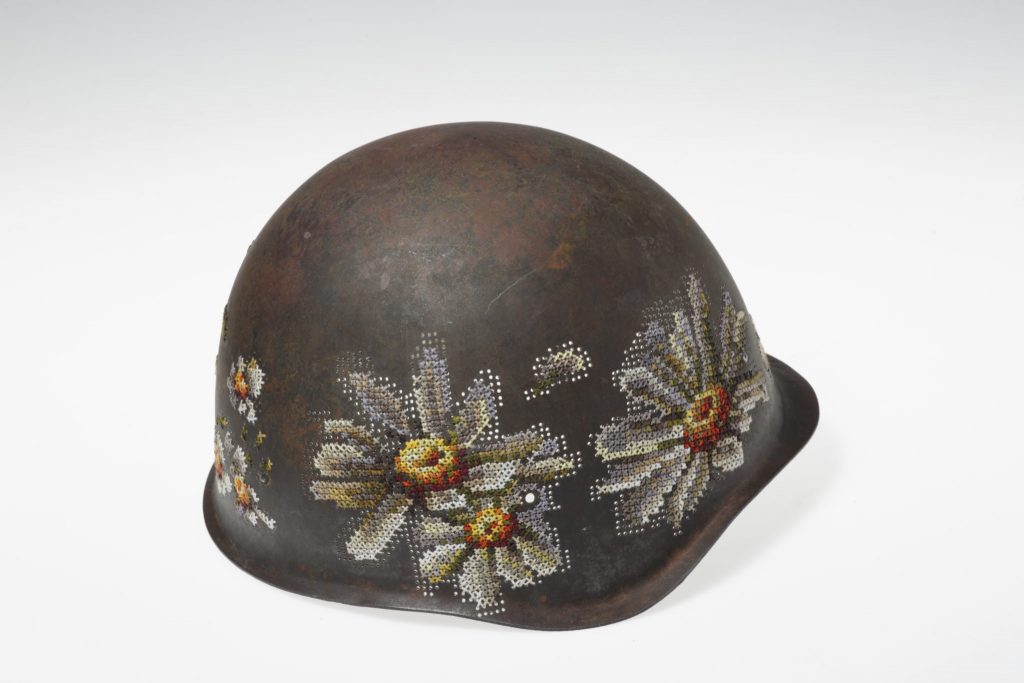
Kill for Peace, Photo by Vidmanatas-Ilčiukas
All helmets were collected in 20-21st century conflict hotspots: World War II, Vietnam War, Balkan Wars, Ukraine… They are from different periods and countries: German, Russian, American… Interestingly, when using my usual technique, perforation, I understood the differences in the attitude of different countries to the lives of their soldiers (some of the helmets were easy to perforate and some – hardly perforable).
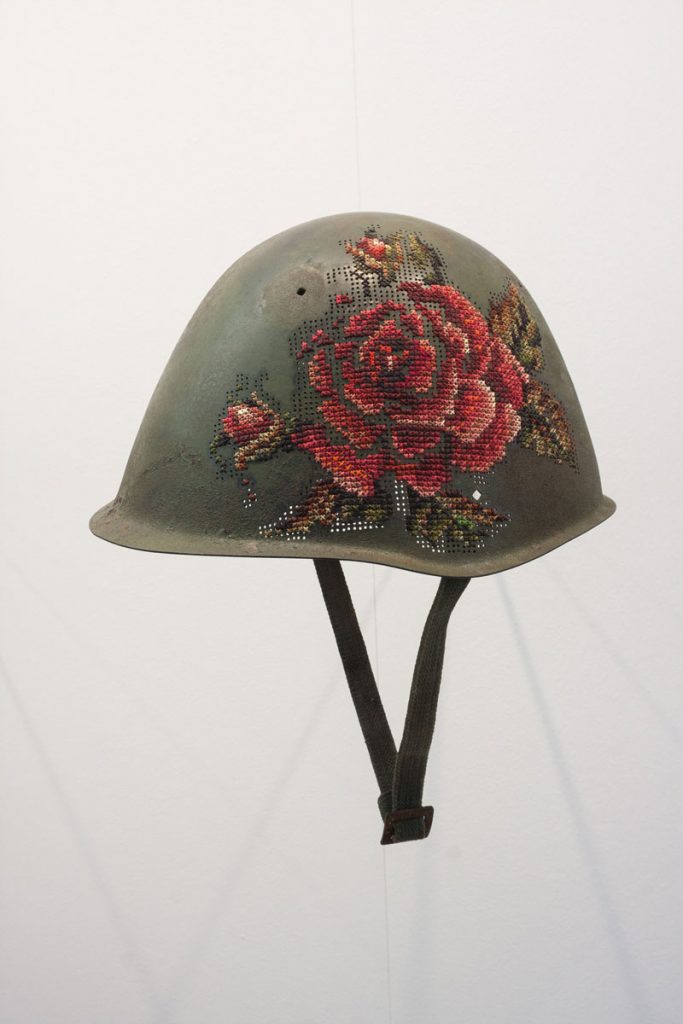
Kill for Peace, Photo by Vidmanatas-Ilčiukas
I received the helmets in different ways. For example, last year, one helmet came directly from the conflict spot in Ukraine and even had the nickname of the soldier inscribed on the inside.
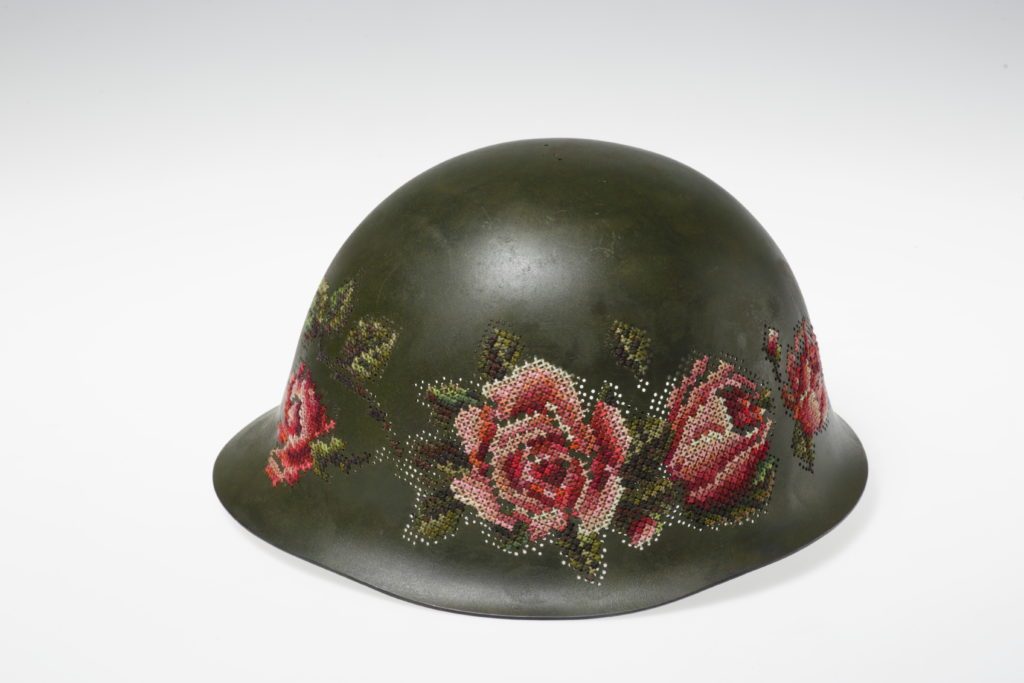
Photo-by-Modestas-Ežerskis
Additional props used in the exhibition
I also used military sweaters to create tapestries, which are hanged on walls and remind of military coats or tents…
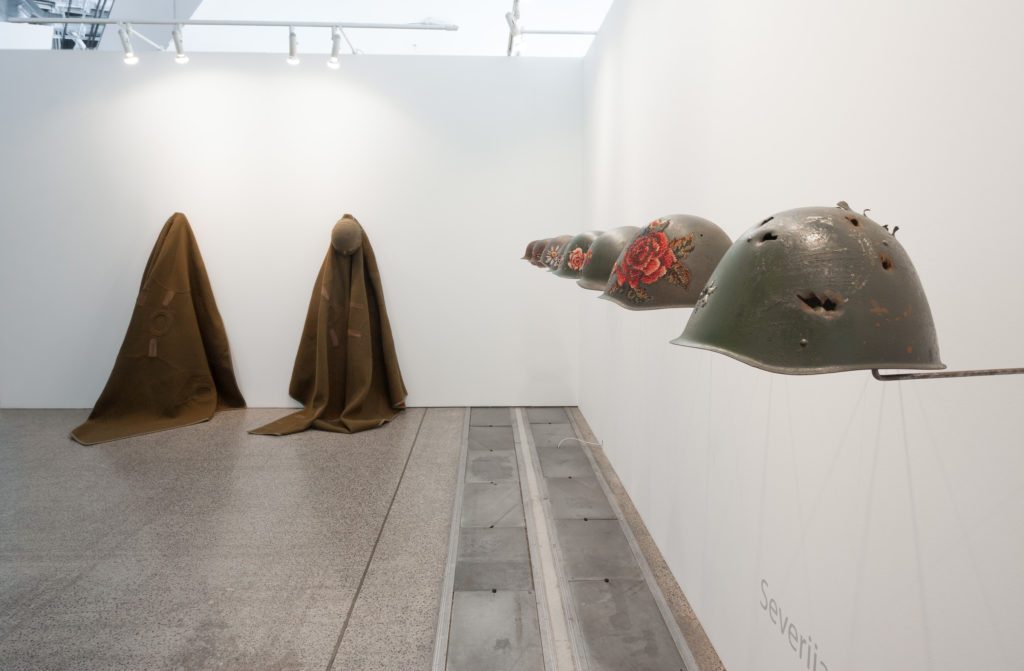
Kill for Peace, Photo by Vidmanatas-Ilčiukas
Discuss the way the helmets were mounted?
They are hanging in one line, the helmets remind us of a cemetery. They also show that all sides lose in military conflicts, death makes us all equal, and many innocent soldiers suffer.
Can you briefly explain the basic technique you use?
This is a very simple – drilling and cross-stitch embroidery.
When you are working on a larger scale how do you adapt the type of thread you use?
I just use a thicker thread.
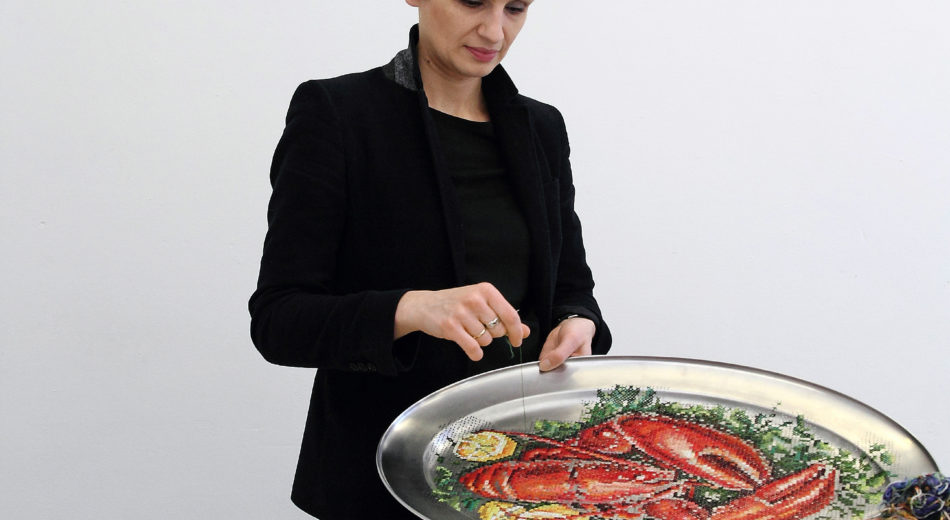
House and I, Magazine, 2016 Photo by Laura-Žaliauskaite
Where do you work?
Usually at home or in the gallery, sometimes in Art Academy.
Expand on the importance to you to making the ordinary into the extraordinary?
Extraordinary art speaks about ordinary lifestyle.
You also work as a teacher and art curator give us some insight into this part of your working life.
Currently, I also work in Vilnius Academy of Arts in two positions: as an associate Professor in Textile Department and also as head of Textile gallery Artifex (which also belongs to the Vilnius Academy of Arts).
I share my experiences with students by teaching and also coordinate exhibitions (most often, textile-related) in the gallery. It is quite complicated to find time for everything, especially for personal creation. But I like working with young people (I can often learn from them myself and find out the interests of young people) and working in the gallery gives me the opportunity to meet interesting artists. Of course, little time is left for personal creation, but all my activities are interrelated and I can manage for now.
Severija at Dismaland Exhibition in the UK
Contact details.
severijaik@gmail.com
Severija Inčirauskaitė-Kriaunevičienė, Vilnius, Lithuania
Interview by Deborah Blakeley, October 2016
Think a colleague or friend could benefit from this interview?
Knowledge is one of the biggest assets in any business. So why not forward this on to your friends and colleagues so they too can start taking advantage of the insightful information the artist has given?
Other artists you may be interested in:


